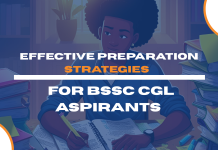The official notification for the recruitment of Grade A Officers was released by NABARD on July 16, 2021. It is always better to start your preparation early so you can stay ahead of the game. A good preparation plan along with complete knowledge will surely let you achieve your goal. In this article, we will discuss how you should prepare for the Descriptive part of the paper on the section of Economic and Social Issues (ESI). We have prepared this article for you covering all the important topics and resources that you need.
ESI Assessment in NABARD Grade A Exam
ESI is a subject that is assessed in both the Prelims and the Mains papers of the NABARD Grade A examination. In the Prelims, 40 objective-type questions are assessed for 1 mark each. ESI is part of the merit section on the basis of which candidates will qualify for the next stage along with Agriculture & Rural Development and General Awareness.
For Phase 2, ESI is assessed with ARD in Paper 2 for the Generalist Post. There will be a total of 36 questions (30 objective and 6 descriptive) questions will be asked. Of these 6 descriptive questions, candidates need to answer only 4. So, all in all, 34 questions will be assessed for 100 marks in total. The descriptive section will be assessed for 50 marks and the time allotted to the descriptive section is 90 minutes.
ESI Syllabus for NABARD Grade A
- Nature of Indian Economy: Structural and Institutional features- Economic underdevelopment- Opening up the Indian Economy- Privatisation
- Economic Reforms in India
- Inflation: Trends in Inflation & their Impact on National Economy and Individual Income
- Poverty Alleviation and Employment Generation in India: Poverty Alleviation Programmes of the Government
- Population Trends: Population Growth and Economic Development – Population Policy in India.
- Agriculture: Characteristics / Status – Technical and Institutional changes in Indian Agriculture – Agricultural performance – Issues in Food Security in India – Non-Institutional and Institutional Agencies in rural credit.
- Industry: Industrial and Labour Policy – Industrial performance – Regional Imbalance in India’s Industrial Development – Public Sector Enterprises.
- Rural banking and financial institutions in India – Reforms in Banking/ Financial sector.
- Globalisation of Economy: Role of International Funding Institutions – IMF & World Bank – WTO – Regional Economic Co-operation.
- Social Structure in India: Multiculturalism – Demographic trends – Urbanisation and Migration – Gender Issues Joint family system – Social Infrastructure – Education – Health and Environment.
- Education: Status & System of Education – Socio -Economic Problems associated with Illiteracy – Educational relevance and educational wastage – Educational Policy for India.
- Social Justice: Problems of scheduled castes and scheduled tribes – socio-economic programmes for scheduled castes and scheduled tribes and other backward classes.
- Positive Discrimination in favour of the under privileged: Social Movements – Indian Political Systems – Human Development. Current Economic & Social Issues.
Best Resources for ESI for NABARD Grade A
Books
- Indian Economy by Mishra & Puri
- Globalisation and the Indian Economy by Ram Prakash Yadav
- Globalisation and Problem of Unemployment in India by Apurba Kumar Chattopadhyay
- Education in India: Policy and Practice by Jandhyala B G Tilak
- Indian Economy by Uma Kapila
- The Essential Writings of B.R. Ambedkar edited by Valerian Rodrigues
- Development as Freedom by Amartya Sen
- Economic & Social Issues in India by Dhrub Kumar
- Social Problems in India Ram Ahuja
Other resources
- Economic Survey of India
- Newspapers
- Press Information Bureau Reports
- The Economic Survey of India
- The Union Budget
- Yojana Magazine
- Kurukshetra Magazine
- Daily Newspaper Editorial Reading
Best Tips to Prepare Descriptive ESI for NABARD Grade A
- Firstly, although descriptive ESI is tested in Phase 2 of the exam, do not wait until Phase 1 is over to begin your preparation. Begin your preparation today itself.
- Frame your answers properly: Since this is a descriptive section of the paper, you must divide your answer as you would an essay. Begin with an introduction to the topic or address the question directly. The body of your answer must contain the direct answer to the question. You can further divide the body into 3 paragraphs. End your answer with a short conclusion on the topic.
- If you are asked to review any scheme or project in the question, feel free to express your opinions politely so long as they are supported by facts.
- In terms of political and ideological trajectories, it would be wise to maintain neutrality.
- In order to make your answer stand out, do not adopt or express any controversial opinions. In fact, doing so may actually go against your favour.
- Along the same lines, you must always end your answer on a positive note.
- Since the exam is computer-based, you should practice typing answers on the keyboard. If you do not have a habit of typing on the keyboard, you may find it challenging to do so on the exam day which will slow you down.
- You must review NABARD Grade A previous years’ papers as well and try to solve the questions by writing the answers. It may sound tedious to write whole essays for practice, but practice makes perfect.
- Free Mock Tests: It is important that you take some mock tests from time to time during the course of your preparation. These will not only help you to understand your preparation but will also help you gauge your speed.
- Do not express or explicitly support any political ideologies in your answer. Similarly, do not name any political party in particular unless specifically asked.
- If someone you know is also preparing for the exam, it would be a great way to peer review each others’ answers.
Types and Sample Questions for Descriptive ESI
Some of the type of questions asked in the descriptive paper are:
- Decision Based (Critically Examine or Discuss)
- Views Based ( What’s your view?/ What’s your take?)
- Schemes Based ( for e.g., PMAY, NULM, PMJDY, PMKVY)
- Reports Based ( EoDB, HDI, GCI, World Freedom Index)
Some sample questions have been listed for you below:
- How have different dimensions of Globalization evolved after the last financial crisis of 2008?
- Analyze the three measures suggested for disinvestment in strategic and non-strategic sectors.
- Analyze the influence of demographic transition on economic growth with reference to India.
If there is anything more that you’d like to know about the NABARD Grade A Syllabus, Eligibility or any related information, you can find all of it at ixamBee.
If you are preparing for the NABARD Grade A 2021 exam, there is no time to lose! Join our NABARD Grade A Online Course that will help you excel in all the subjects in this exam. Remember, you have the potential to not only clear the exam but excel at it. So, without further ado, take our demo course before you make ixamBee your companion in this journey!
Also read
How to Prepare Quantitative Aptitude for NABARD Grade A/B 2021
NABARD Grade A 2021: Eligibility and Exam Pattern
NABARD Grade A/B 2021: Decision Making Syllabus and Preparation
NABARD Grade A 2021 Official Notification Released! Major Changes in Eligibility & Exam Pattern














